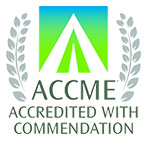Physicians

This activity has been planned and implemented in accordance with the accreditation requirements and policies of the Accreditation Council for Continuing Medical Education through the joint providership of Center for Independent Healthcare Education (Center) and Vemco MedEd. Center is accredited by the Accreditation Council for Continuing Medical Education to provide continuing medical education for physicians.
Center designates this Enduring material for a maximum of 0.75 AMA PRA Category 1 Credit(s)™. Physicians should claim only the credit commensurate with the extent of their participation in the activity. Physician Assistants
AAPA accepts AMA PRA Category 1 Credit™ for the PRA from organizations accredited by ACCME. Nurse Practitioners
Nurse Practitioners will receive certificate of AMA PRA Category 1 Credit™ as this is an ACCME accredited program and its accreditation is recognized by Nurse Practitioner boards. For questions regarding the accreditation of this activity, please contact us at info@jointsponsor.com Method of Participation and Instruction for Credit
- Review the entire CME information including target audience, learning objectives, and disclosures.
- Review the activity in its entirety.
- Complete the Online Post Test, Evaluation, and Credit Application form
- Please note that to receive credit you must achieve a score of at least 80%.
- Certificate of Credit will be emailed to you within 4 weeks.
|
Disclosure of Financial Relationships with Ineligible Companies
Center for Independent Healthcare Education and Vemco MedEd fully comply with the Standards for Integrity and Independence in Accredited Continuing Education in development of CME/CPE activities. We require the full disclosure of financial relationships with ineligible companies from all individuals in a position to influence the content of a certified activity, in any amount occurring within the past 24 months. All relevant financial relationship is identified by the provider and mitigated to prevent inserting commercial bias into content. All identified relevant financial relationships are disclosed to the learners prior to the activity. The faculty is further required to disclose discussion of off-label uses in their presentations.
Disclosures
Diane K. Newman, DNP reported the following relevant financial relationships with ineligible companies:
Advisory Board: Urovant Sciences
All relevant financial relationships have been mitigated.
Dr. Newman does not discuss off-label uses of any products.
No (other) speakers, authors, planners or content reviewers have any relevant financial relationships to disclose.
Content review confirmed that the content was developed in a fair, balanced manner free from commercial bias. Disclosure of a relationship is not intended to suggest or condone commercial bias in any presentation, but it is made to provide participants with information that might be of potential importance to their evaluation of a presentation.
Fee
There is no fee to participate in this activity.
Hardware/Software Requirements
Microsoft Internet Explorer, Mozilla Firefox, Apple Safari or Google Chrome with the QuickTime Plug-in
Note: Please disable any “pop-up blocker” features.
System Check
Please e-mail any questions or concerns to info@vemcomeded.com.
Copyright Statement
Copyright © 2022 Vemco MedEd. All Rights Reserved. Permission for accreditation use granted to Center for Independent Healthcare Education.
Privacy Policy
http://www.vemcomeded.com/privacy.asp
Joint Providership
This activity is jointly provided by Center for Independent Healthcare Education and Vemco MedEd.
Commercial Support
This activity is supported by an educational grant from Urovant Sciences, Inc.
|


